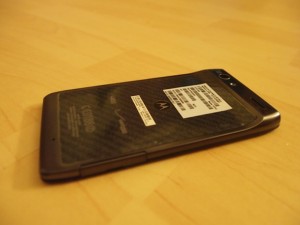Motorola's Droid Razr: Does it work for women?

When the Samsung Infuse 4G was released earlier this year with its 4.5-inch display, I questioned whether or not smartphones are becoming tablets. Motorola's Droid Razr continues to push the dimension boundaries -- and not in a good way.
[Image Gallery: Motorola Droid Razr hands-on (photos)]
For reference, the Droid Razr sports a 4.3-inch Super AMOLED, advanced qHD display. The dimensions measure 130.7 x 68.9 x 7.1 mm (5.15 x 2.71 x 0.28 inches), and the device weighs 127 grams (4.48 ounces) overall.
On the plus side, the thinness and the weight are overwhelmingly positive aspects of the external design. The display itself is fine too.

- The 1080p HD camera sticks out at the top on the back of the phone.
- The phone itself (not the display) is too long and too wide.
The majority of the people I showed it to agreed that if maybe the Droid Razr was an inch shorter, it would be an OK device. But that still doesn't mean they'd buy it. (I'll acknowledge that my sample group was over a dozen people, most of whom are in their late 20s and early 30s, but a fairly even divide among men and women.)
Women, in particular, are going to be very turned off by the Droid Razr. It falls into a category that I like to refer to as "man phones." Generally, Android phones heavily populate this category for me because Android ecosystem partners -- especially Motorola -- like to produce really giant smartphones. Just look at the Droid X and the Droid Bionic, for starters.
I wouldn't mind if the iPhone was a bit bigger because the larger screens really do lend themselves well to people who want to stream videos and read frequently on their phones.
But I want to be able to hold my smartphone in one hand comfortably, to which neither I nor any other woman I showed the Droid Razr could do. Even most guys I showed it to (all of whom own other large Android smartphones) replied that the Droid Razr was awkward to hold and too big.
What I really don't understand is why do mobile OEMs want to keep making smartphones bigger -- to the point where it feels like we're going back to Zack Morris-like cell phones. (See photo.) Isn't the whole point of new technology to become smaller and thinner in order to be cool? But I digress...
I don't think the idea of further bridging the gap between smartphones and small tablets is such a good one either. The 5-inch Dell Streak didn't make it, and only a few devices (i.e. Nook Color, Kindle Fire, Galaxy Tab), have shown there is demand for even a 7-inch tablet. So what need is there for smartphones step in here?
When the original Razr flip-style, featurephones were released several years ago, they were actually stellar devices for their time. They were compact, stylish and operated as decently as anyone could want from a consumer cell phone in the mid-2000s.
It almost seems that Motorola just released the Droid Razr to try to ignite some sort of nostalgic feeling from those customers. As as Motorola (and Android in general) smartphones go, the Droid Razr isn't really that impressive.
For those who do want a super-slim smartphone with an extra-large display, maybe you should hold off for the Samsung Galaxy Nexus, which, magically, doesn't actually seem that imposing. The Ice Cream Sandwich-powered device hasn't been released yet, but I got to see one hands-on recently for a very brief period of time (less than 30 seconds).
Instantly I thought this smartphone would be more pleasing to a greater population of consumers. Yes, it has a 4.65-inch screen, but the display takes up more real estate on the phone, which has a less awkward shape overall.
To sum up, there are plenty of other great options, such as the Samsung Galaxy S II, on the market now for consumers looking for a large Android smartphone.
Related:
- Gallery: Droid RAZR vs. iPhone 4 and unboxing
- Motorola Droid RAZR: Not quite thin enough to cut metal (review)
- Four Motorola devices get dibs on Ice Cream Sandwich
- Motorola's third quarter: 4.8 million smartphones shipped
- Motorola Droid RAZR: an impressive combination of two huge brands (first impressions)
- Google, Samsung unveil Android 4.0-based Galaxy Nexus
- iPhone tops RAZR in sales; twice as reliable as Blackberry